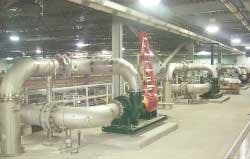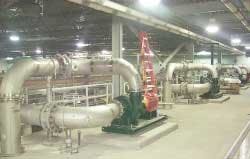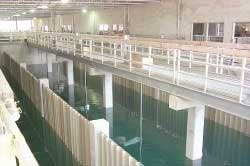Detroit Plant Project Features Design, Build, Maintain Approach
By Alexander J. Varas and Michael V. Broder
A new $275-million, 240-mgd water treatment plant under construction in Detroit is based on an innovative project delivery system pioneered by Detroit Water and Sewerage Department (DWSD). The system's design/build/ maintain (D/B/M) approach is attracting attention nationwide.
By including maintenance in a design/build contract, in this case for seven years, DWSD expects that the contractor will focus more intently on the quality of the design, thereby ensuring the delivery of a plant that minimizes future maintenance issues. For example, attention will be paid to equipment access for either corrective or preventive maintenance, thus ensuring proper care and extended equipment life.
Hazen and Sawyer, a firm that has been providing consulting services to DWSD for over 40 years, and at Water Works Park since 1980, is serving an oversight role as DWSD's onsite representative, responsible for overseeing the design and construction. The project is being performed by the Detroit Water Team (DWT), a consortium of 11 firms, including J.S. Alberici Construction, Walsh Construction, Motor City Electric, Black and Veatch, and Montgomery Watson Harza. DWT began its work in December 1998 and will complete the new plant in 2003.
Project History
In 1980, DWSD initiated a program to rehabilitate and upgrade the existing 325 mgd Water Works Park plant. The plant, in operation since the 1920's, occupies 110 acres on the shore of the Detroit River. However, by the mid-1990s, operation and maintenance costs, as well as projected costs of treating water to the higher standard of anticipated water quality regulations, convinced DWSD to explore options for better plant efficiency.
Hazen and Sawyer conducted a study in 1996 that showed that the cost of continuing to rehabilitate the existing facility and construct the necessary changes to meet future regulations approached the cost of a replacement plant. Based on the study, DWSD opted for the surety of a new plant over the potential of unknowns in rehabilitating and modifying the existing facility.
Hazen and Sawyer's six-month pilot study established the proposed new plant's basis of design and enabled DWSD to obtain process regulatory approval from the Michigan Department of Environmental Quality (MDEQ). By performing the piloting and obtaining regulatory approvals, DWSD provided the D/B/M teams an advanced starting point on which to base their proposals.
Plant Features
The new 240 mgd plant will have flash mixing, three-stage flocculation, high-rate sedimentation using plate settlers, intermediate ozonation, and filtration at a loading rate of 8 gpm/sf - double the previous maximum rate permitted by the MDEQ. Use of these high-rate unit processes will result in a physically smaller plant than one based on more "conventional" loading rates. The work also includes a new eight million gallon underground finished water reservoir and rehabilitation of a 20 million gallon underground finished water reservoir. The new plant will rely upon an existing raw water intake and a high lift pumping station.
D/B/M Process
Concurrently, Hazen and Sawyer assisted DWSD in developing the project requirements and the D/B/M procurement and selection process, and solicited qualifications submittals for the construction of a 240 mgd (expandable to 320 mgd) plant. After preparing minimum standards for design and construction, and assembling geotechnical, topographical, and other data on the project site and existing plant (which was to be kept in operation during new plant construction and then demolished), a request for proposals was issued to the short-listed teams in November 1997. Teams were given four months to prepare their proposals. The City and Hazen and Sawyer then entered an intensive phase of proposal clarifications, evaluations, and negotiations with the selected D/B/M team, the Detroit Water Team.
This project represents the largest design/build effort for a water treatment plant in the nation. The traditional public works procurement method of design/bid/build would have added 42 months to the 52-month design/build schedule, and roughly $90 million to the $275-million D/B/M contract cost. Part of the savings was realized by the earlier decommissioning of the existing plant.
Design-Build vs. Traditional Approach
Design-build is a project delivery method in which the same entity or team both designs and constructs the project, compared to traditional design-bid-build, where different entities design and construct the project. The major differences of design-build compared to design-bid-build are:
- The design-builder provides the owner with single-point contractual responsibility - it warrants the success of the complete project, whereas under design-bid-build the contractor only warrants its construction work.
- The design-builder may factor cost and constructibility more highly than other issues important to the owner such as quality design and construction.
- The owner's role now includes functions traditionally performed by the designer - preparing the project specifications and overseeing the project's implementation.
- Design-build's potential benefits to the owner may include faster project delivery time, earlier project cost determination, single-point responsibility, fewer claims, and better-value design. The design-builder also realizes potential benefits: greater control over the project, and avoiding the sometimes adversarial relationship between owner/ designer and builder.
- For the owner, the potential risks of design-build include the absence of a design professional to protect the owner's interests, potential reduction in the owner's input into the design quality and details, and potentially higher costs for changes in scope.
Maximizing Benefits/Minimizing Drawbacks
One approach to minimizing design-build's drawbacks is to extend the design-builder's responsibilities to include operation of the facility over a fixed period (as long as 25 years). The project specification can then be a true performance specification, where, for a water treatment plant, the owner would be concerned only with the quality and quantity of the drinking water produced by the plant, and not how it was achieved.
DWSD, however, has a keen interest and strong opinion regarding building and system design, and material and equipment selection, since it would be operating the facility. By including an extended maintenance period (for seven years at Water Works Park), DWSD expects that the design-builder will include quality design principles and construction methods in order to avoid future maintenance problems. DWSD is also using the following procedures to maximize the benefits of design-build:
- Retaining its own design professional - Hazen and Sawyer - to prepare the project specifications, including the basis of process design and minimum design and construction standards; assist in evaluating proposals and negotiating the design-build contract; assist in overseeing the selected design-builder's work; and assist DWSD in all applications to state and local regulatory agencies.
- Holding informal, confidential, non-binding, one-on-one meetings with design-build proposing teams during the proposal preparation period to allow opportunity for teams to explore the acceptability of innovative design and construction ideas and concepts.
- Upon the initial review of the proposals, having proposers respond in writing to questions the owner may have regarding its proposal. This clarification stage enables the reviewers to limit their assumptions and interpretations of the proposals, and assists in defining the scope of work of the successful proposer by becoming part of the contract.
Conclusion
With DWSD's D/B/M modification to design/build project delivery, DWSD anticipates that it will obtain a water treatment plant that meets or exceeds its expectations in design and construction quality, as well as reduced maintenance requirements.
About the Authors:
Alexander J. Varas, P.E., is a Vice President, and Michael V. Broder, P.E., is a Senior Associate at Hazen and Sawyer. Varas is the Project Manager and Broder is the Technical and Construction Manager of the oversight project at Water Works Park. Varas has over 30 years of experience, and Broder has over 20 years of experience in managing large municipal water and wastewater projects.


